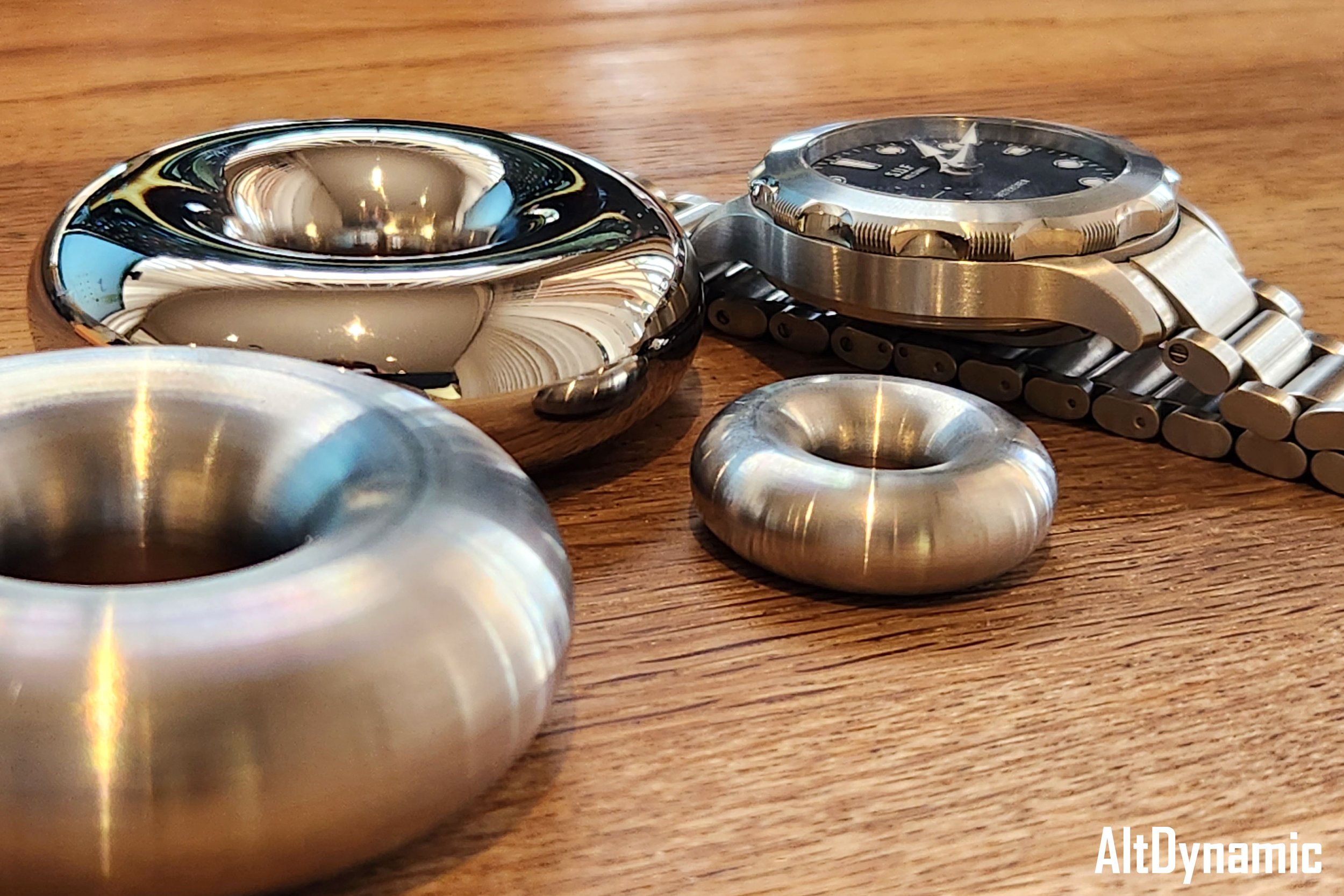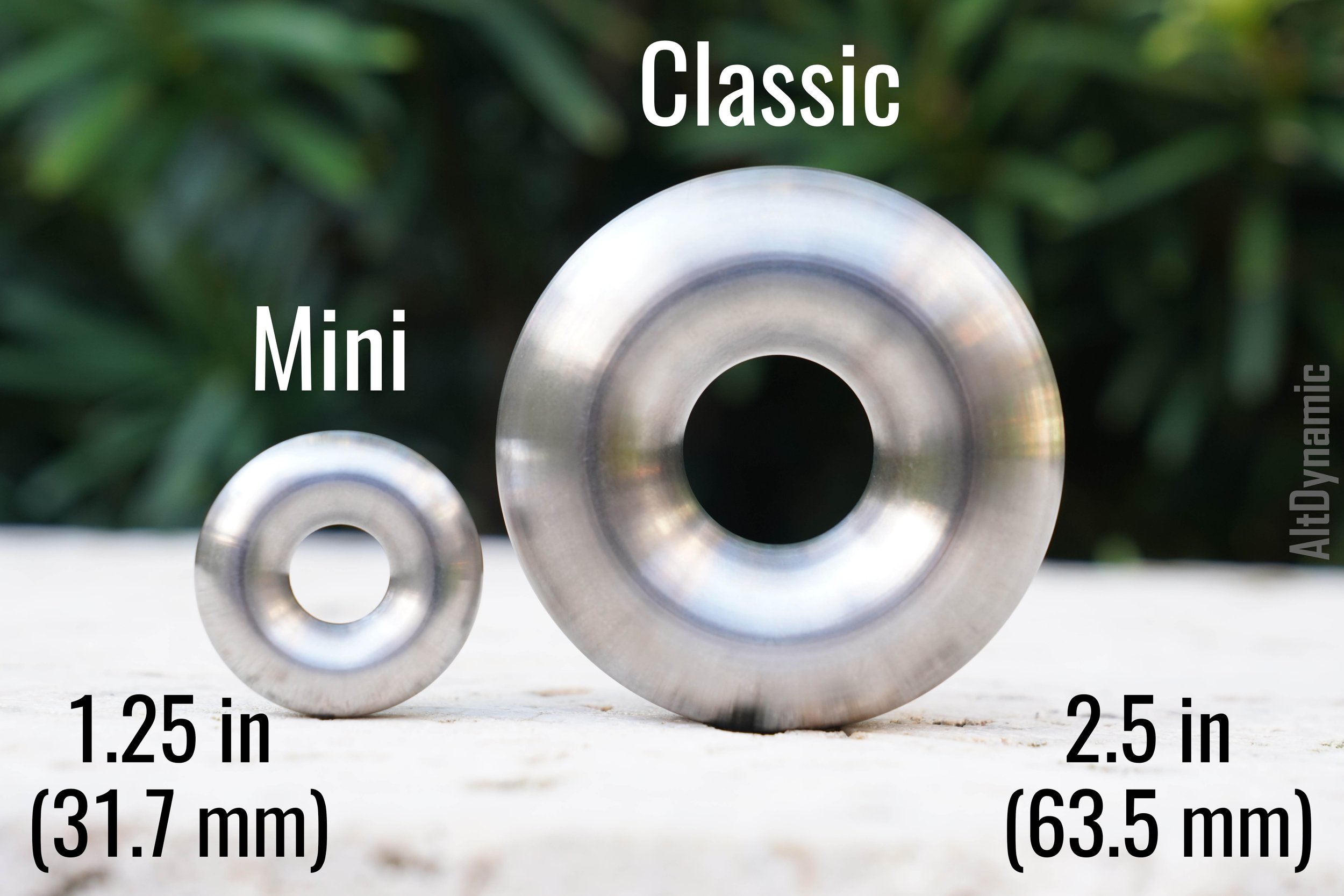The Torus
The Torus: a compact, oriented 2D-manifold with genus 1
Precision machined Titanium & Stainless steel ring Tori. A topologist's best friend.
Cleaning & Care: Warm water and gentle hand soap are preferred methods for removing dirt and skin oils from your Torus. A soft towel should be used for drying.
Affectionately nicknamed the "donut", the venerable Torus is the cousin of the degenerate Sphere. The ancient Greek (300 BC) mathematicians Euclid, Archimedes and Proclus are normally credited with discovering the Torus (though they did not specifically point it out). Centuries later, academics from Rene Descartes, Leonhard Euler, Felix Klein, John Nash and Albert Einstein would all be required to use the Torus to help discover Calculus, push the limits of Topology, Partial Differential Equations and General Relativity.
The Torus is quite ubiquitous in electrical engineering where they can be found in: electric motors, transformers in AC electronics, O-rings, Optics, Magnets, Nuclear Fusion Tokamaks and much more.
On the surface, the Torus may seem like a basic shape, but that can't be further from the truth. It is a complex structure and is a symbol of how humanity has developed methods for understanding the world around us. This campaign's goal is to encapsulate the concept of the Torus in precision machined, solid Titanium and Steel to create one of the highest quality Torus shapes ever made.
Whether you're a mathematician, engineer, an artist, or simply someone who appreciates beautiful objects, our Torus is sure to impress.
Math Talk
The numerous and arcane areas in mathematics the Torus occupies, make it extremely difficult to describe its importance in the short, simplified context of this Kickstarter campaign. Nevertheless, we've given it a go...
Our inclusion of a bakery donut, coffee mug and our machined Torus, stems from a common joke in the field of Topology. You have to understand, topologists don't consider straight lines/distances/angles. As long as they can stretch or distort a surface without a cutting it, a circle, triangle and square are all the same. Analogously, if you think of a donut as deformable clay, it can be compressed into the shape of a coffee mug. All three shapes are considered homeomorphic.
Topologists view the Torus as a single holed, 2D orientable surface with a genus of one. To the rest of us, the classical ring Torus is a surface generated by revolving a circle (radius r, AKA minor radius) around a coplanar axis which does not tangentially touch or intersect it. The major axis, R, is the distance from the center of the circle to the axis. For a ring Torus, (R > r).
Orientability is the property whereby we can give direction to determine up vs. down. An orientable surface has two sides (a Mobius strip is not orientable since it has 1 side). We can orient a surface by using the normal unit vector from any point on the surface, and can establish direction by which way the vector points (vectors have magnitude and direction). Genus, simply put, means a shape has a hole in it (A sphere, a cube and icosahedron all have a Genus of zero).
This relates to the Euler Characteristic V-E+F=2, which might look familiar to most in this form, F+V=E+2, where (F=faces, V=vertices, E=edges). All spheres and polyhedra have a Euler Characteristic of 2, which is why this nifty equation can be used in grade school geometry text books. When a hole is introduced ( aka Genus 1), the Euler characteristic changes from 2, to 0. This is the Euler Characteristic general equation: X=2-2g, where g is Genus. This simple equation and the Genus concept allows the differentiation among surfaces and manifolds. It is the foundation for advanced study throughout topology and the sciences, for example, the Euler characteristic helps describes phases of matter in condensed matter physics.
Design & Precision Machining
Each Torus is machined from a solid bar of Stainless Steel or Titanium. We will NOT be casting them. Below you can see how our Torus compares to some of our other shapes.
Other AltDynamic shapes: Tesseract, Superegg, Mobius Strip, Orbiform, Torus, HexaSphericon, da Vinci Dodecahedron
Dimensions
Mini Diameter: 1.25 in. ( 31.7 mm)
Classic Diameter: 2.5 in. ( 63.5 mm)
Weights
Titanium - Classic Weight: 7.3 oz, 207 g, Mini Weight: .9 oz, 25.5 g
Steel - Classic Weight: 13 oz, 369 g, Mini Weight: 1.6 oz, 45 g
Titanium is roughly half as dense as Steel. A US nickel is .18 oz (5 g), for reference.
Material Notes
The main difference between a Titanium Torus and a Steel one is that the Steel one is nearly twice as heavy. In mirror finish and machine finish, they are nearly the same color. The most prominent difference is with Satin finish, as Titanium is much greyer, than Steel is. Both metals are similar in terms of scratch resistance.
Finishes - Machine, Satin, Mirror Polish














